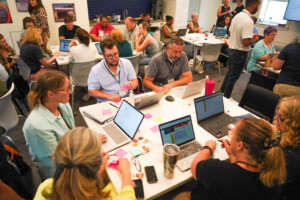18 Examples of State Policies that Support Competency-Based Programs

We’ve been looking into what schools, districts, networks, and impact organizations are doing to accelerate progress toward an effective CBE system, and in July we will release a full publication highlighting our research and analysis. In the meantime, we have assembled a series of initial lists of positive examples in various areas.
ExcelInEd released the report “Policy, Pilots and the Path to Competency-Based Education: A National Landscape” in Spring 2017, which tracks the CBE policy efforts states have made thus far. Below is a listing of state policy examples grouped by features of: flexibility from time-based systems, competency-based diplomas, acceptance of competency-based diplomas and credits by higher education, flexible learning, state assessments, and innovation pilots.
This list is not intended to be comprehensive, but is a sampling of initiatives identified as exemplars by people we’ve interviewed and/or other sources we’ve encountered in our research. We invite you to suggest other policies supporting competency-based education in the comments section below.
Flexibility from Time-Based Systems
New Hampshire abolished the Carnegie Unit and awards credits diplomas based on demonstrations of competency rather than seat time (codified as Minimum Standards for School Approval).
Note: Many other states have not yet changed statewide policy, but have created an option for LEAs to move away from time-based requirements, at least under certain circumstances.
Michigan allows Local Education Agencies (LEAs) to apply for a waiver of the minimum seat-time requirements.
Oregon’s credit options allow LEAs to offer credits based on demonstration of proficiency. This can include completion of classroom or equivalent work “designed to measure proficiency or mastery of identified standards (knowledge and skills) in class or out of class, where hours of instruction may vary.”
Utah’s State Board of Education defined a “non-traditional program” to include distance learning, blended learning, online learning, or competency-based learning. The policy allows LEAs to “adopt a written policy that designates a continuing enrollment measurement…for each student enrolled in the nontraditional program.”
Competency-Based Diplomas
Maine is transitioning to a proficiency-based diploma for all students, adopting a set of Guiding Principles to define cross-curricular skills for which each student must demonstrate proficiency for high school graduation.
Michigan authorized funding to develop and pilot a competency-based transcript and marketplace to “provide enhanced choice to pupils and parents for the completion of requirements for a high school diploma.” The transcript to be developed and piloted is to be “pupil-owned” and to allow students to satisfy college admission requirements, accumulate credentials and credits, matriculate to postsecondary, and prepare for early career success.
Vermont requires LEAs to have proficiency-based graduation requirements based on state standards, starting with the graduating class of 2020. Schools may use credits to demonstrate a student has met graduation requirements; if they do, credits must not be based on time and must specify the proficiencies demonstrated to attain a credit.
Acceptance of Competency-Based Diplomas and Credits by Higher Education
Utah included a requirement that the institutions of higher education shall recognize and accept a diploma earned in a competency-based program in the enabling legislation for the Competency-Based Pilot Grants.
The New England Secondary Schools Consortium (NESSC) is a collaboration of five states that encourages proficiency-based graduation and personalized learning pathways. The group has worked to secure a statement of support from 68 public and private institutions of higher education which “states—unequivocally—that students with proficiency-based grades and transcripts will not be disadvantaged in any way” in the admissions process.
Anytime, Anywhere Learning
Louisiana’s Course Access program (Supplemental Course Academy) is considered the most developed nationally. Hundreds of online and face-to-face courses are offered by providers that have gone through a rigorous state review and approval process. The system uses a flexible funding model.
Florida Virtual School, established in 1997, is focused on “any path, any pace, any time, any place” learning. Credits are awarded in these online classes based on individual student progression, rather than time-based requirements.
State Assessment Systems that Support CBE
Florida end-of-course (EOC) assessments, aligned to the Florida Standards (FS), are administered for biology, U.S. History, Civics, Algebra 1, Algebra 2, and Geometry.
New Hampshire’s Performance Assessment for Competency Education (PACE) began under the state’s Elementary and Secondary Education Act (ESEA) waiver. A small number of LEAs are voluntarily piloting the system, 11 of which include reduced standardized testing together with locally developed common performance assessments designed to support deeper learning and to be more integrated into students’ day-to-day work than current standardized tests. The inspiration for ESSA’s Innovative Assessment and Accountability Demonstration Authority, PACE includes:
- Common performance tasks that have high technical quality;
- Locally designed performance tasks with guidelines for ensuring high technical quality, regional scoring sessions, and local LEA peer review audits to ensure sound accountability systems and high inter-rater reliability;
- A web-based bank of local and common performance tasks; and
- A regional support network for LEAs and schools.
Virginia has been administering online tests for over a decade and is transitioning many of its statewide assessments to computer adaptive testing, with most students taking computer adaptive mathematics tests in grades 3, 6, 7, and 8 in 2015-16. Many tests also allow students to indicate their responses in ways other than multiple choice answers. This program was expanded in 2016-17.
Innovation Pilots Focused on CBE
Idaho authorized the creation of an initial cohort of incubators for mastery-based education in FY2017. Sites are intended to provide data and best practices for continued implementation of mastery education across the state.
Ohio’s Competency-Based Education Pilot allowed five applicants to plan and implement competency-based education programs. The Ohio Department of Education selected five sites in March 2016, each of which to receive up to $200,000 per academic year during the pilot. Ohio also allowed that participating students will be considered as traditional full-time equivalent students for purposes of state funding.
General Innovation Programs
Colorado’s Innovation Schools Act authorizes innovation zones and innovation schools. Local school boards have the authority to designate an innovation school or innovation zone based on a plan submitted by the school or schools. The permissible innovations include the length of school day and year student promotion and graduation policies, and the assessment plan.
Georgia’s Innovation Fund began as a part of Georgia’s Race to the Top plan and provided grants to invest in local efforts “to plan, implement and scale innovative education programs that advance student achievement” throughout the state. To continue the Innovation Fund’s work, Georgia Governor Nathan Deal has appropriated state funding for the Governor’s Office of Student Achievement to administer grants to organizations focused on planning, implementing, or scaling programs aligned with the Innovation Fund’s priority areas.
What other examples would you add? As mentioned above, please feel free to contribute to the list by adding a comment below.
Additionally, keep an eye out in the coming weeks for follow-up lists that will highlight other interesting CBE resources, initiatives, and difference-makers! And be sure to check back for the final publication, which will be launched in mid-July.
This post is part of a series focused on competency-based education in partnership with XQ Institute. The series highlights findings from research and interviews conducted during the development of the upcoming white paper, “Show What You Know: The State of Competency-Based Education.”
For more, see:
- 10 Corporate and Higher Education Examples of Competency-Based Programs
- Helpful Tools for Providing Effective Competency-Based Education
- Philanthropic Organizations Making an Impact in Competency-Based Education
Stay in-the-know with all things EdTech and innovations in learning by signing up to receive the weekly Smart Update. This post includes mentions of a Getting Smart partner. For a full list of partners, affiliate organizations and all other disclosures, please see our Partner page.






Bruce William Smith
New Zealand's National Certificate of Educational Achievement is the most advanced system of this sort that I know of in the world; check out its system of credits being awarded and certificated based on the achievement of standards, which has been fundamental to the assessment system we've been developing for One World College. Other international efforts along these lines worth noting are the end-of-course assessments in Quebec, the National Assessment Bank and Curriculum for Excellence units in Scotland, and the Australian Curriculum's online posting of exemplars to standardize portfolio assessment.